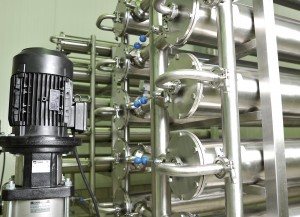NANOFİLTRASYON MEMBRANLARI
Nanofiltrasyon, ters osmoz ve ultrafiltrasyon arasında molekül ayırımını yapan bir sistemdir. Birçok çok değerlikli iyon (sülfat-karbonat gb) membranda tutulurken tek değerlikli iyonların seyrelmiş çözeltileri genellikle engellenmeden membrandan geçerler. Nanofiltrasyonun bu mükemmel ayırma kabiliyeti, ya bir akışkanın istenmeyen maddelerini ya da değerli maddelerini seçimli olarak konsantre etmesine olanak tanır. NF uygulamaları demineralizasyon, renk giderimi ve tuz giderimidir.
Membran Özellikleri
Nanofiltrasyon yaklaşık 0,001 μm por çapına sahip olup membranlarının moleküler ayırma sınırı MWCO 180-2.000 Da arasındadır. Böylece bu molekül ağırlığına sahip bileşenler daha büyük molekül ağırlığına sahip bileşenlerden kolayca ayrılabilir. Yaygın olan uygulama basınç aralığı 3 – 40 Bar’dır ve membranların yüzeyi hafif yüklüdür. Yük etkileşimi ayırma işleminde önemli rol oynar
AMFOR NF SPİRAL SARILI MEMBRANLAR
Nanofiltrasyon membranlarının seçiciliğini bileşiğin alıkonması ve geçirgenliği belirler. Alıkonma, bileşiğin boyutuna (ör; molekül ağırlığı) bağlıdır. Nanofiltrasyon membranlarına göre alıkonma ve geçirgenlik çözeltideki moleküllerin ve tuzların yük değerleri ve elektrik yüklerinin bir fonksiyonudur.
Nanofiltrasyonda iki değerli ve tek değerli katyonların özellikle kalsiyum ve magnezyumun geri çevrilme oranı bu nedenle yüksektir. Nanofiltrasyon, ters osmoz öncesi ön-arıtma olarak kullanıldığı kadar endüstriyel su yumuşatma uygulamalarında da yaygın olarak kullanılır.
Nanofiltrasyon membran gözenek yapısı ters osmoz membranlarına göre daha büyüktür. Nanofiltrasyonda ters osmoza göre daha fazla tuzun geçmesine izin verilir. NF, RO’a göre yüksek geri kazanım vardır ve düşük konsantrede sıvı akış hızı nedeniyle su kullanımının korunmasını sağlar. İkisi arasındaki diğer ana fark, klor gibi tek değerli tuzların uzaklaştırılmasıdır. Ters osmoz ile uzaklaştırılan tek değerli iyon düzeyi 200 psi’da %98-99 iken NF’de %50-90 arasındadır. NF membranları çok çeşitli olduğu için tek değerli iyonların uzaklaştırılması membran materyaline ve membran üretimine bağlıdır. Nanofiltrasyon sistemi RO sisteme göre sistemde gerekli olan besleme basıncı daha düşüktür. NF sistemde kirlenme hızı RO sisteme göre daha düşüktür.
AMFOR® NF membranlar, çözünenlerin ayrılması istenen proses uygulamaları için tasarlanmıştır. NF membran tek değerli tuzları geçirirken, molekül ağırlığı 200Da’dan büyük olan organiklerin geçisini engelleyecek şekilde tasarlanmış dayanıklı membranlardır.
Membran tipi: Poliamit ince film kompozit
Moleküler ayırma sınırı: 200-300Da
FDA yönetmeliğine uygundur
AMFOR NF HİJYEN MEMBRANLAR
- NF-1812 CaCl2 ve MgSO4
- NF-4040 CaCl2 ve MgSO4
- NF-2540FF CaCl2 ve MgSO4
- NF-3838FF CaCl2 ve MgSO4
- NF-4040FF CaCl2 ve MgSO4
- NF-1812
- NF-2540
- NF 2319
- NF 6338
- NF 8040
-
NF-8040 CaCl2 ve MgSO4
- NF-8040FF CaCl2 ve MgSO4



